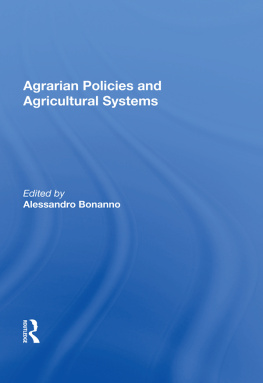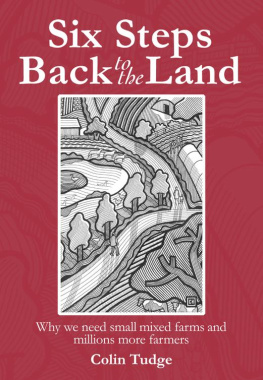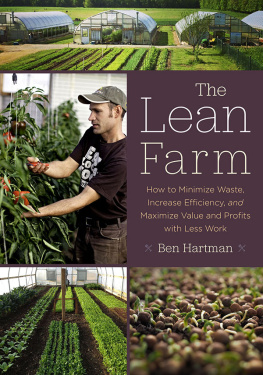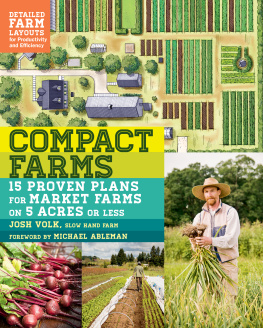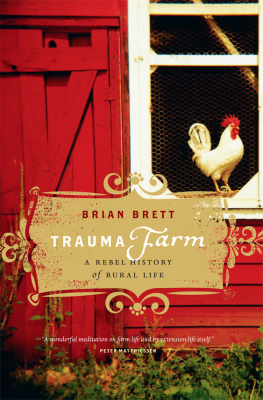
Small Farms
Rural Studies Series
Rural Publie Services: International Comparisons, edited by Richard E. Lonsdale and Gyrgy Enyedi
The Social Consequences and Challenges of New Agricultural Technologies, edited by Gigi M. Berardi and Charles C. Geisler
Rural Society in the U.S.: Issues for the 1980s, edited by Don A. Diliman and Daryl J. Hobbs
Technology and Social Change in Rural Areas: A Festschrift for Eugene A. Wilkening, edited by Gene F. Summers
Science, Agriculture, and the Politics of Research, Lawrence Busch and William B. Lacy
The Cooperative Extension Service: A National Assessment, Paul D. Warner and James A. Christenson
The Organization of Work in Rural and Urban Labor Markets, Patrick M. Horan and Charles M. Tolbert II
The Impact of Population Change on Business Activity in Rural America, Kenneth M. Johnson
Small Farms: Persistence with Legitimation, Alessandro Bonanno
Studies in the Transformation of U.S. Agriculture, edited by Eugene Havens with Gregory Hooks, Patrick H. Mooney, and Max J. Pfeffer
About the Book and Author
Why do small farms continue to coexist with ever-larger farming operations in advanced Western societies? Through a thorough case study of Italy and a comparative analysis of small farms in the United States, Dr. Bonanno seeks to answer this question, exploring the complex relationships among farm family members ideology and behavior, the small farm economic sector, and the interaction of small farms within the relevant spheres of society. He finds that, at the structural level, a lack of occupational alternatives and contradictions within both labor and land markets often force farmers to retain marginal farms despite personal dissatisfaction. At the ideological level, many farm families display deep attachment to the agrarian way of life and cite this as a fundamental reason for not leaving the farm for other work.
Dr. Bonanno also analyzes the role of small farms within the social system and concludes that they serve a legitimative function. This legitimative role fosters contradictions within the social and economic systems that the state is unable to resolve, thus contributing to the continuation of a dual structure in agricultural development-large and very large farms at one end of the scale and marginal but persistent small farms at the other.
Dr. Alessandro Bonanno is assistant professor of rural sociology at the University of MissouriColumbia. After undergraduate and graduate work at the University of Messina, Italy, he obtained masters and doctors degrees in sociology at the University of Kentucky.
THE RURAL STUDIES SERIES of the Rural Sociological Society
Board of Editors 19861987
Frederick H. Buttel, Cornell University (Chair)
Charles C. Geisler, Cornell University (Associate Chair)
Rabel J. Burdge, University of Illinois
Frederick C. Fliegel, University of Illinois
Theodore D. Fuller, Virginia Polytechnic Institute and State University
Steve H. Murdock, Texas A&M University
Eileen S. Stommes, New York State Department of Agriculture and Markets
Rural Studies Series, Sponsored by the Rural Sociological Society
First published 1987 by Westview Press
Published 2019 by Routledge
52 Vanderbilt Avenue, New York, NY 10017
2 Park Square, Milton Park, Abingdon, Oxon OX14 4RN
Routledge is an imprint of the Taylor & Francis Group, an informa business
Copyright 1987 by the Rural Sociological Society
All rights reserved. No part of this book may be reprinted or reproduced or utilised in any form or by any electronic, mechanical, or other means, now known or hereafter invented, including photocopying and recording, or in any information storage or retrieval system, without permission in writing from the publishers.
Notice:
Product or corporate names may be trademarks or registered trademarks, and are used only for identification and explanation without intent to infringe.
Library of Congress Catalog Card Number: 86-051502
ISBN 13: 978-0-367-28740-5 (hbk)
To the dedicated men and women around the world who live and work on small farms
Tables
Figures
Figure A
Region Surveyed
During the several years necessary for the research and writing of this book, I had the opportunity and privilege to count on the assistance of a number of friends and colleagues. I would like to acknowledge here those who directly or indirectly contributed to the realization of this project. Among them a special thanks goes to my teacher and friend, Larry Busch, who guided and advised me throughout the entire process. I am also indebted to Kathy Blee, Dwight Billings, David Dickens, Herb Reid and Lou Swanson, who read all or parts of my manuscript. Their comments were fundamental in eliminating a number of confused concepts, distorted understandings and misconceptions from the final version of the text. My Italian friends, Tonino Perna, Peppino Restifo and Amedeo Macri, spent several months with me in the field interviewing farmers. Their input made the interviewing process much more interesting and pleasant. I also would like to mention the contributions of the colleagues officially involved in the reviewing process for the Rural Studies Series. Their recommendations and remarks have been greatly appreciated. Writing a book, however, is not just carrying out a research project and conceptualizing the results; it also involves the long and arduous processes of typing and editing. On this front I was surrounded by a number of very competent and talented individuals. Ann Stockham carefully read a preliminary version of the book, eliminating stylistic imperfections and errors of distraction that are difficult to catch in a long manuscript. Pat Nelson and Debbie Garrett typed the entire manuscript and were patient enough to retype the revisions and addenda I kept putting on their desks. The most important thanks, however, goes to my wife Lucy Lee-Bonanno, who read all versions of the manuscript and carefully edited them. A great deal of her writing skills are embodied in this book. Thank you, Lucy, for your help. Finally, I would like to thank the farmers and their families who so openly and enthusiastically answered my questions. To them, to their commitment to farming, to their love for the land and their way of life this book is dedicated. As sole author I assume all responsibility for the content of this book.
Alessandro Bonanno
Columbia, Missouri
This book examines the reasons for the persistence of small farms in marginal areas of one advanced Western country, Italys Northeastern Sicily and Southern Calabria. Furthermore, it places emphasis on the international dimension of the phenomena, particularly with respect to the case of the United States.
Several considerations motivate this topic of study. First, emphasis has been placed on the decline in the number of small farms in most of the advanced Western countries (Fabiani, 1979; Fanfani, 1977; Klatzmann, 1978; Lin, Coffman, and Penn, 1980). This emphasis is not new in the literature, as students of the structure of agriculture both in the recent and less recent past have stressed a continuous decline in the number of small farms (Bogart, 1942; Ernele, 1936; Young, 1809). However, despite this trend it can be argued that the decline has not assumed a constant and gradual posture, for there have been periods in which the number of small farms has increased (Beale, 1978; Chantfort, 1982; Mottura and Pugliese, 1980). It can also be argued that the proportion of small farms within the structure of agriculture in most advanced Western countries has either remained virtually unchanged or, in some instances, has increased (Chantfort, 1982; Kautsky, 1971b; Mottura and Pugliese, 1980). Moreover, it has been stressed that in the future there will be a continuous expansion of the relative presence of small farms in the agricultural structure. In a discussion of the composition of American agriculture in the year 2000, a recent study concluded: The farms will probably be arranged in a bimodal distribution-a large portion of small farms, an ever-increasing proportion of large farms, and a declining proportion of medium size farms (Lin, Coffman, and Penn, 1980:iii). Consequently, despite an absolute decline in the number of small farms and despite the fact that their disappearance from the agricultural structure has been directly or indirectly implied for quite some time, small farms in advanced Western countries continue to represent a substantial and important portion of the agricultural structure.


